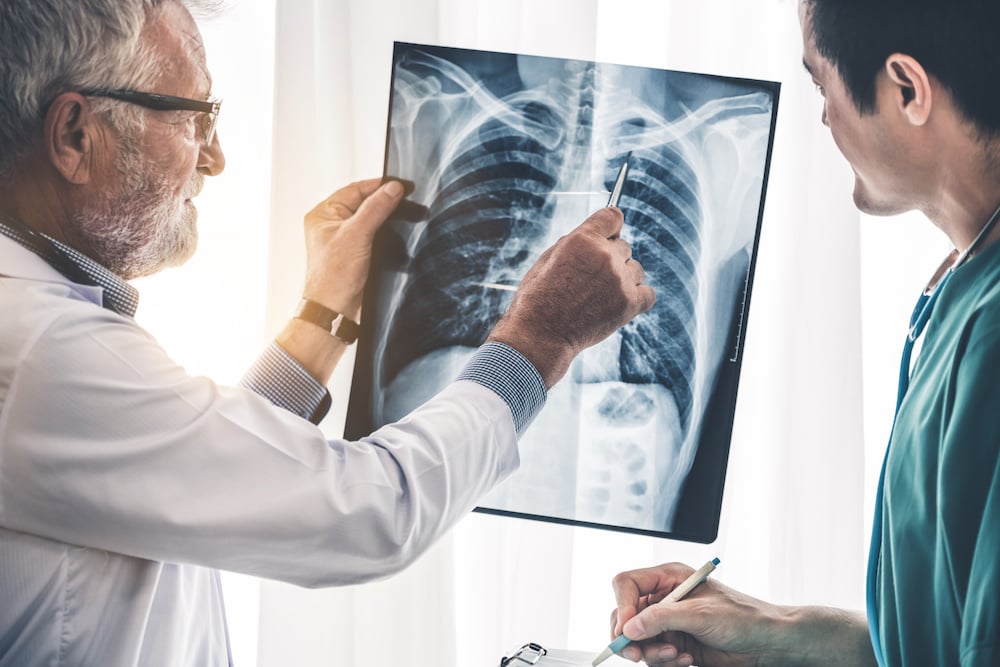Lung Carcinoid Tumors: Are They Lung Cancer?
5 min read

Lung carcinoid tumors, often referred to as just “lung carcinoids” are a rare type of lung cancer, comprising only 2% of all lung cancers. This particular type of lung cancer isn’t usually caused by smoking. That’s because the cells where the tumors start are part of the neuroendocrine system. When located in the lungs, neuroendocrine cells help control air and blood flow, control the growth of other lung cells, and detect oxygen and carbon dioxide levels so the lungs can adjust. They’re extremely important to our bodies. Sometimes these cells grow too fast and slowly develop into tumors.
Types of Lung Carcinoid Tumors
Neuroendocrine cells exist throughout your entire body, but only neuroendocrine cells in the lungs can develop into lung carcinoid tumors. If neuroendocrine cells start growing too fast, they can form one of two types of carcinoid tumors – typical or atypical.
- Typical carcinoids, which account for 90% of lung carcinoid tumors, grow slowly and rarely spread.
- Atypical carcinoids grow faster and are more likely to spread to other organs. Atypical tumors are slightly more common in people who smoke.
Carcinoid tumors are also classified by their location in the lung.
- Central carcinoids are most common and grow on the walls of the lung’s large airways near the center of the lung.
- Peripheral carcinoids grow on the edges of small airways.
The tumor’s location can determine a patient’s symptoms and affects treatment.
Carcinoid Tumor Symptoms and Diagnosis
About 75% of people who have lung carcinoid tumors typically have symptoms. The most common are coughing, wheezing, chest pain, or shortness of breath. Coughing may produce blood in the phlegm. A large tumor can block air passages and pneumonia.
A rare set of symptoms called carcinoid syndrome can cause:
- Flushed or red face and neck
- Wheezing, shortness of breath, or asthma-like symptoms
- Weakness
- High blood pressure or fast heart rate
- Weight gain
- Diarrhea
- Body and facial hair increases (hirsutism), especially in women
Some of the symptoms of lung carcinoids are similar to other conditions. Your doctor will need to run tests to see what’s causing them.
How are Carcinoid Tumors Diagnosed?
Carcinoid tumors are often first diagnosed when you’re being evaluated for another problem, such as a chest X-ray for a lung infection.
Your diagnosis is based on a physical exam, symptoms, and your medical history. Additional diagnostic testing may include chest X-rays or a computed tomography scan (CT).
Imaging X-rays may not reveal a tumor if it’s very small or hidden by other chest structures. CT scans provide more detail via a cross-sectional view of the lungs. CT scans can also indicate if the cancer has spread beyond the lung.
Blood and urine tests can reveal if your hormone levels are normal and check for the presence of substances that indicate a carcinoid tumor. These tests can be helpful in patients with carcinoid syndrome symptoms.
Bronchoscopy and biopsy will give the ultimate answer about whether the tumors are cancer. To see inside the lung, a bronchoscopy is performed by inserting a thin, flexible camera into the windpipe to take the sample using direct vision. Once inside, the doctor may choose to take some samples of the tumor once it’s found.
The tumor sample that’s removed during the biopsy will be tested to determine if it’s a lung carcinoid tumor. And if it is, the pathologist will also determine if it’s considered typical or atypical. This will direct the oncologist on which treatments to use.
How are Lung Carcinoids Treated?
The most common treatment for lung carcinoids is to have them surgically removed. Typically, the lymph nodes surrounding the tumor are also removed.
The surgical procedure your oncologist will use depends on the tumor’s location and size. If it’s in a large airway, only the section containing the tumor is removed. If it’s on the edge, a small wedge of the lung is removed. In some cases, especially if there are multiple tumors, a lobectomy is performed to remove that area of the lung.
Lymph node removal is usually done at the same time so they can determine if cancer has spread to the nodes. This can also reduce the risk of the cancer spreading outside of the lungs.
For patients with typical lung carcinoids, surgery may be all that’s needed. For those with atypical lung carcinoids, other treatments may be needed. This is often done to prevent it from spreading to other areas of the body. These treatments can include:
- External beam radiation therapy to kill any cancer cells left behind from surgery. Sometimes brachytherapy, or internal radiation, is used. It places tiny pellets or rods that are loaded with radiation material and places them inside or next to the tumor. Early-stage cancer typical carcinoid patients who cannot have surgery will be treated with radiation therapy.
- Chemotherapy is used less often for lung carcinoids. For those with atypical lung carcinoids who also have lymph nodes affected, chemotherapy is more likely.
What’s the Prognosis for Carcinoid Tumor Lung Cancer?
Most patients have a good outcome after carcinoid lung tumor treatment. About 90% of patients with typical carcinoid lung tumors will live at least another five years; this drops to 50% to 70% for patients with atypical carcinoids. Survival rates are typically lower for cancer that’s spread beyond the lung.
How are Lung Carcinoid Tumors Different from Lung Cancer?
Carcinoid tumors in the lungs act differently from other types of lung cancer such as non-small cell lung cancer and small cell lung cancer. Here’s how they differ:
- Origin – lung cancer begins in the lung cells, while lung carcinoids start in neuroendocrine cells found in the lungs.
- Growth rate – lung cancer grows at a much faster rate than slow-growing carcinoid lung tumors.
- Spread – untreated lung cancer is more likely to spread beyond the lung compared to carcinoid tumors, which rarely spread.
- Treatment – lung cancer is treated with surgery, radiotherapy, chemotherapy, targeted therapy, and/or immunotherapy. Surgery is the primary treatment for most lung carcinoids.
- Prognosis – generally, those with lung cancer are more likely to have their cancer return because it’s usually found at a later stage when it’s harder to completely kill all the cancer cells in the body. Lung carcinoids recur in only about 3% of patients.
While it’s frightening to receive a lung cancer diagnosis, you have excellent prospects for a complete cure if your diagnosis is a lung carcinoid tumor. This rare type of lung cancer requires an accurate diagnosis and the latest treatment protocols. That level of care is available through the lung cancer specialists at Rocky Mountain Cancer Centers. Our cancer centers are located throughout Colorado including the Denver metro area, Boulder, Colorado Springs, and the front range. You’ll receive expert treatments, caring side effects management, and a treatment plan designed specifically for your needs. If you have been diagnosed with lung cancer, find the RMCC cancer center near you and schedule an appointment with one of our lung cancer specialists.
